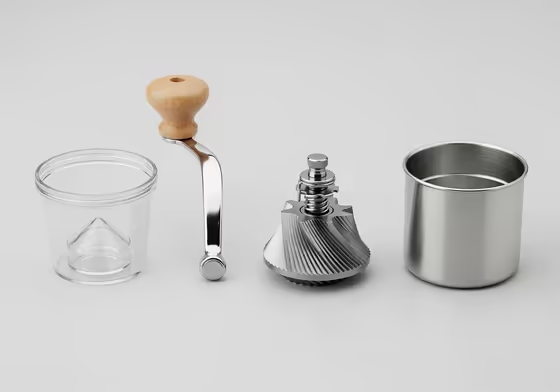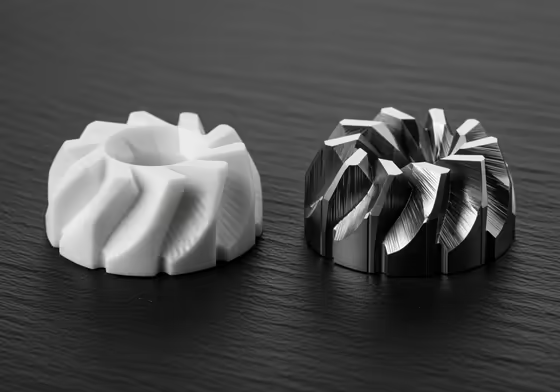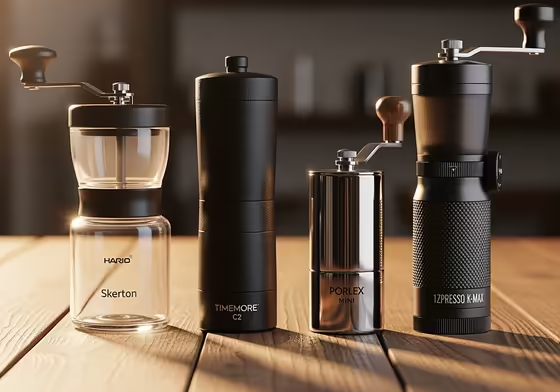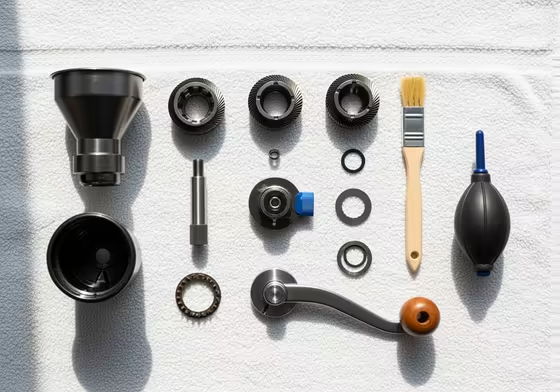A Guide to Hand Coffee Grinders
If you want to make better coffee at home, the best thing you can buy is a good burr grinder. A hand grinder is a great choice. They often give you a better grind than electric grinders that cost a lot more .
What Is a Hand Coffee Grinder?
A hand coffee grinder is a tool you use to grind whole coffee beans by hand. It uses burrs to create coffee grounds that are all the same size. This consistency is key for a good-tasting cup of coffee.

How Hand Grinders Work
A hand grinder has four main parts.
- The Hopper: This is where you put the whole coffee beans.
- The Handle: You turn this to grind the beans. A longer handle can make grinding feel easier.
- The Burrs: This is the most important part. It has two pieces that crush and cut the beans into a consistent size.
- The Grounds Chamber: This part at the bottom catches the ground coffee.
Why Burrs Are Better Than Blades
Many people new to coffee use a blade grinder, which is often sold as a spice grinder. But a burr grinder is much better for coffee. The difference is huge.
- Blade Grinders: These use a propeller-like blade to chop up beans. This creates a mix of large chunks and fine dust.
- Burr Grinders: These use two special surfaces to grind beans into an even size.
Having evenly sized grounds is very important . When you brew coffee, water pulls flavor out of the grounds. If the grounds are uneven, your coffee won't taste right.
The small dusty parts will make it taste bitter . The big chunks will make it taste sour . A good burr grinder gives you an even grind for a balanced and tasty cup.
How to Use a Hand Grinder
Using a hand grinder is easy. Just follow these steps for a great grind every time.
- Set Your Grind Size. Before you add beans, pick how coarse or fine you want your grounds. You usually do this by turning a dial on the grinder.
- Add Your Beans. For the best coffee, weigh your beans on a scale first. Then, pour them into the hopper at the top.
- Grind the Coffee. Put the lid back on so beans don't fly out. Hold the grinder with one hand and turn the handle with the other in a steady, smooth motion.
- Use Your Grounds. When the handle spins freely, you're done. Just unscrew the bottom part and put your fresh grounds into your coffee maker.
Hand Grinder vs. Electric Grinder
People often wonder which type of grinder is better. The answer really depends on what's important to you. Think about grind quality, ease of use, cost, and if you need to take it with you.
Pros of Hand Grinders
- They're small and light, so you can take them anywhere.
- They are much quieter than electric grinders.
- They are built to last because they have few parts and no electronics.
- Many people enjoy the process of grinding their coffee by hand.
Pros of Electric Grinders
- They are fast and easy to use, grinding coffee with the push of a button.
- They can usually hold and grind more beans at once.
But here's the most important difference: how much you pay for quality. A hand grinder's price is all about the quality of its burrs and how stable it is. An electric grinder's price has to cover the burrs, a motor, and other electronics.
This means a $150 hand grinder can often grind as well as a $500 electric one. With an electric grinder, you're paying extra for the convenience of a motor. If you just want the best grind for your money, a hand grinder is the way to go.
Is Grinding Your Own Beans Worth It?
Yes, it absolutely is . Grinding your beans right before you brew is the biggest thing you can do to improve your coffee's taste.
Here's why. A whole coffee bean protects all the oils and flavors inside. The moment you grind it, you expose those flavors to the air.
You know that great smell of fresh coffee grounds? That's the best part of the flavor leaving the coffee and disappearing into the air. After about 15 minutes, a lot of that flavor is gone for good.
Grinding your own beans also gives you control. You can choose the perfect grind size for your coffee maker. This is something you can't do with pre-ground coffee.
Some people think grinding changes the caffeine, but that's not true. Caffeine levels depend on the type of bean you use, not how you grind it.
Are Hand Grinders a Good Value?
If you care a lot about how your coffee tastes, a good hand grinder is definitely worth the money. They are the cheapest way to get cafe-quality coffee at home. Even pro baristas use them in competitions.
You get the grind quality of a very expensive electric grinder for a much lower price. But this value comes with a few downsides.
Downsides of Hand Grinders
Even the best hand grinders aren't perfect. The main problems are about effort, time, and how much they can grind at once.
-
It Takes Effort.
Grinding by hand takes physical work, and some things make it harder.
- Roast Level: Lighter coffee roasts are much harder and denser than dark roasts. Grinding them can be a real workout.
- Grind Size: It takes more time and effort to get a fine grind for espresso than a coarse grind for a French press.
- It Takes Time. It's slower than an electric grinder, which can be a problem on busy mornings.
- Limited Capacity. Most hand grinders only hold enough beans for one or two cups of coffee. Grinding for a big pot of coffee might mean grinding several batches.
How Long Do Hand Grinders Last?
A good hand grinder can last for ten years or even longer. They are simple and don't have motors or electronics that can break.

The only part that wears out over time is the burrs. How long they last depends on what they're made of.
- Ceramic Burrs: These are very hard and can grind around 750 pounds of coffee before wearing out.
- Stainless Steel Burrs: These are a bit less durable and can grind about 500 pounds of coffee.
So if ceramic burrs last longer, why do all the best new hand grinders use stainless steel? It's all about performance.
- They Are Faster. Steel burrs are sharper and cut the beans efficiently. A modern steel burr grinder can be 4 to 5 times faster than a cheap one with ceramic burrs.
- They Are More Precise. Steel can be shaped into more complex designs. This gives you a more consistent grind and clearer flavors in your coffee.
- They Are More Stable. Older grinders with ceramic burrs often had plastic parts inside that would wobble. Modern steel burr grinders use metal parts and bearings to keep everything steady for a very even grind.
The first popular hand grinders used ceramic burrs. But today's best grinders use steel burrs. They give you a faster and more consistent grind.
The Best Hand Coffee Grinders
There's no single "best" grinder for everyone. The right one for you depends on your needs, how you make coffee, and your budget. This guide is broken down by what you might be looking for.

Top Hand Grinder Brands and Models
Here's a look at some of the top brands, from entry-level to high-end grinders.
1. Hario (The Classic Starter)
- Overview: Hario grinders, like the Skerton and Mini Mill, were the first upgrade for many coffee lovers. They use ceramic burrs and are a big improvement over a blade grinder.
-
Models:
- Hario Skerton: This is Hario's larger grinder. It can hold 60 grams of beans or more, which is good for making bigger batches.
- Hario Mini Mill: This is a smaller, travel-friendly grinder. It holds about 30 grams and has a plastic catch cup instead of glass.
- Key Differentiator: Older Hario grinders could be wobbly when set to a coarse grind, making them inconsistent. The Mini Mill has a spring that makes it more stable, so it's often better for things like French press.
- Verdict: These are good grinders to start with. But their performance isn't as good as newer grinders with steel burrs.
2. Timemore (Best Budget Pick)
- Overview: Timemore changed things for people on a budget, especially with its Chestnut C2 model. It's often called the best budget-friendly grinder you can buy.
-
Why it's so good:
The Timemore C2 brought features from expensive grinders to a much lower price point:
- Hardened Steel Burrs: These give you a fast and even grind that's much better than older ceramic models.
- Dual Bearing Stabilization: Two sets of bearings hold the main axle steady. This gets rid of "burr wobble" and makes the grind very consistent.
- Aluminum Body: The grinder feels solid and well-made.
- Verdict: For most people starting out, the Timemore C2 or C3 is the best value. It gives you amazing grind quality for the price.
3. Porlex II (Best for Travel)
- Overview: The Porlex is a grinder from Japan with a tough stainless steel body and ceramic burrs.
- Unique Value Proposition: The main selling point of the Porlex Mini is its size and shape. It's designed to fit perfectly inside an AeroPress coffee maker.
- Porlex II vs. I: The newer "II" model has better ceramic burrs that grind faster. It also has a stronger handle connection.
- Verdict: You buy a Porlex for travel. It's portable and nearly indestructible, making it a great choice for AeroPress users on the go.
4. 1Zpresso (Best for Enthusiasts)
- Overview: 1Zpresso is a company that has become very popular with coffee fans. Their grinders offer top-tier performance for a mid-range price.
- The "Problem": The only confusing part about 1Zpresso is their product line. They have many different models, and it can be hard to know which one to choose.
-
Decoding the 1Zpresso Lineup:
The best way to understand their grinders is by looking at how you adjust the grind size. This tells you what the grinder is best for.
- J-Series (like J-Ultra, J-Max): These are built for espresso. They have a very fine adjustment system, with each click making a tiny change. This is exactly what you need to get the perfect espresso shot.
- K-Series (like K-Ultra, K-Max): These are great all-around grinders. They can handle everything from espresso to French press. Their adjustment clicks are a bit larger, which makes it easier to switch between different brew methods.
- Verdict: So here's the bottom line. If you mainly drink espresso, get a J-series grinder. If you want one excellent grinder for everything, get a K-series.
Best Hand Grinder for Espresso
It's a common mistake to think that any hand grinder can make espresso. This usually just leads to frustration. You need a specific type of grinder to do it right.
Can I use a hand grinder for espresso?
Yes, but only if you have the right kind of hand grinder . Espresso brewing forces hot water through a tightly packed puck of coffee. The grinder's job is to create grounds that provide the perfect resistance to that water.
This is why you need to make very small "micro-adjustments" to the grind size. A tiny change can make a big difference in your espresso shot. If a grinder's adjustment clicks are too far apart, you'll have a hard time getting it right.
- One setting might be too coarse, making the shot watery and sour .
- The very next setting might be too fine, choking the machine and making the shot bitter .
You need to be able to find the perfect setting in between those two clicks. A real espresso grinder has to have these tiny adjustment steps so you can find that sweet spot.
Recommended Espresso Hand Grinders
- Top Pick: 1Zpresso J-Ultra. This grinder is built for espresso. Its tiny adjustment steps give you amazing control.
- Other 1Zpresso Picks: The J-Max and JX-Pro are also great choices for espresso.
- The Classic: Comandante C40. This is a fantastic all-around grinder that can work for espresso. But its adjustment steps are larger and it's less convenient for making small espresso adjustments.
- What to Avoid: Budget grinders like Hario, Porlex, and the basic Timemore models are not made for espresso. They won't be able to get the grind fine or consistent enough.
Hand Grinders for Large Batches
The main downside of most hand grinders is that they don't hold many beans. If you often make large pots of coffee, you'll need a bigger grinder. There aren't many options, but here are a few good ones.
- Hario Skerton: This is the most common large hand grinder. It can easily hold 50-60 grams of beans.
- Orphan Espresso Lido 3: This is a large, heavy-duty grinder with big steel burrs. It can hold up to 70 grams of beans.
- Orphan Espresso Apex: This is a huge grinder that you mount on a countertop. It's for people who want to grind a lot of coffee by hand.
For most people, it's easier to just grind two batches in a better grinder like a 1Zpresso. But if you always need to grind 60 grams or more at once, the Skerton or Lido are good options.
Using Your Hand Coffee Grinder
Once you've chosen a grinder, it's time to learn how to use it well. This really comes down to grind size and how long it takes.

Finding the Right Grind Size
The "best" grind size is just a starting point. Every coffee is different, so you'll need to make small adjustments. The best way to do this is by tasting your coffee.
If it tastes sour , grind finer . If it tastes bitter , grind coarser .
The following table gives you good starting points for popular hand grinders. The settings are measured in "clicks from zero," which is the tightest setting.
| Brew Method | Visual Description | 1Zpresso K-Series (e.g., K-Ultra) | 1Zpresso J-Series (e.g., J-Ultra) | Comandante C40 | Timemore C2/C3 | Hario Skerton/Mini |
|---|---|---|---|---|---|---|
| French Press / Cold Brew | Very Coarse (like kosher salt) | 7.5-9.0 (K-Max) | 3.5-4.0 | 55-65 clicks | 22-26 clicks | 9-12 clicks |
| Chemex (Large) | Medium-Coarse (like rough sand) | 7.0-8.0 (K-Max) | 3.0-3.5 | 45-55 clicks | 20-24 clicks | 8-10 clicks |
| Pour Over (V60/Drip) | Medium (like regular sand) | 5.5-7.0 (K-Max) | 2.5-3.0 | 40-50 clicks | 14-20 clicks | 6-9 clicks |
| AeroPress | Medium-Fine (like table salt) | 4.0-6.0 (K-Max) | 2.0-2.5 | 18-30 clicks | 14-20 clicks | 4-8 clicks |
| Moka Pot | Fine (finer than table salt) | 4.0-5.0 (K-Max) | 1.8-2.2 | 15-20 clicks | 10-14 clicks | 3-5 clicks |
| Espresso | Very Fine (like powdered sugar) | 2.6-3.5 (K-Max) | 1.2-1.8 | 10-17 clicks | 6-10 clicks (Not Rec.) | 1-3 clicks (Not Rec.) |
| Note: These are just starting points. You should adjust the grind based on how your coffee tastes. |
How Long Does It Take to Grind by Hand?
Many people worry that grinding by hand takes too long. This used to be true with older grinders that had ceramic burrs. But modern grinders with steel burrs are very fast.
For example, grinding enough coffee for one cup of pour-over usually takes:
- About 37 seconds on a Timemore C3
- About 29 seconds on a 1Zpresso K-Max
For most single cups, grinding takes between 30 and 60 seconds. This is often faster than it takes for your water to boil. The time isn't really a problem unless you're grinding very fine for espresso.
How to Clean Your Hand Grinder
A hand grinder is something you can own for a long time. Cleaning it properly is important to protect it and make sure your coffee always tastes great.
Why You Need to Clean Your Grinder
Yes, you absolutely do . A dirty grinder can make even the best coffee beans taste bad. There are two main reasons to keep it clean.
- Rancid Oils: When you grind coffee, oils get left behind on the burrs. Over time, these old oils go bad and can make your coffee taste stale and bitter.
- Stuck Particles: Tiny bits of old coffee grounds get stuck inside the grinder. These stale grounds will mix with your fresh coffee and ruin the flavor.

How to Clean Your Grinder
Light Clean (Weekly): A quick clean once a week is usually enough. Use a small brush and an air blower to clear out any loose grounds from the burrs and catch cup.
Deep Clean (Every 1-3 Months): Every few months, you should take the grinder apart to remove built-up oils.
- Take it apart. Work over a towel so you don't lose any small parts. Take off the handle, grounds cup, and adjustment knob, then carefully remove the inner burr, spring, and central rod.
-
Clean the burrs.
Use a stiff, dry brush (like a toothbrush) to scrub all the coffee dust and oil off both burrs.
Important Warning: Never use water to clean the burrs, especially if they are made of steel. Water will cause them to rust, permanently damaging your grinder.
- Wash other parts. The hopper, handle, and grounds cup can usually be washed with warm, soapy water.
- Dry everything completely. This is the most important step. Any moisture left inside can damage the grinder's metal parts.
- Put it back together. Reassemble the grinder in the reverse order you took it apart.
A Quick Warning: The Rice Myth
You might see tips online that say you can clean your grinder by grinding uncooked rice in it.
If you want to use a product you can grind through, buy special cleaning pellets like Grindz. They are made from grains and are designed to be soft enough to clean without causing damage.